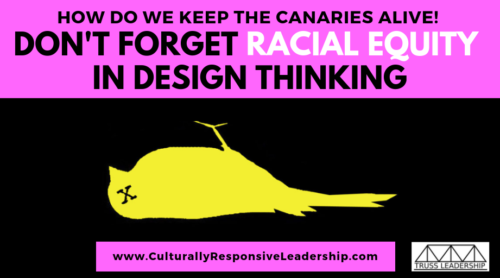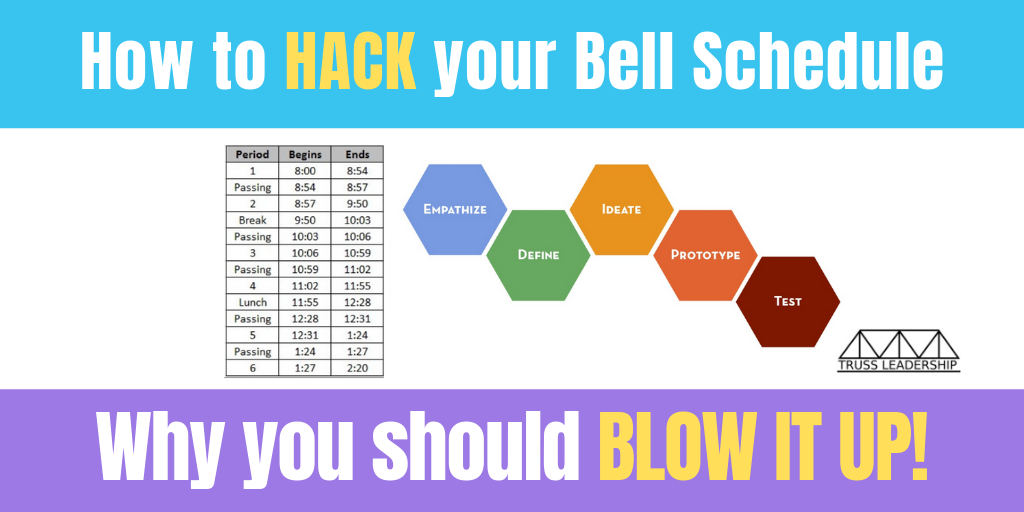Keep the Canaries Alive: Design Thinking Meets Racial Equity in Schools
You may WANT to redesign your bell schedule, but how do you do it with equity in mind? What process can you go through, where can you get inspiration, and what are some pitfalls to avoid? And how the hell do you keep the canaries alive?
I previously have written about why we need to abandon our archaic bell schedules and what happened at our school, but I want to go deeper into the process to share HOW we did it. I hope that folks can learn from our process and see which pieces might be helpful in your innovation.
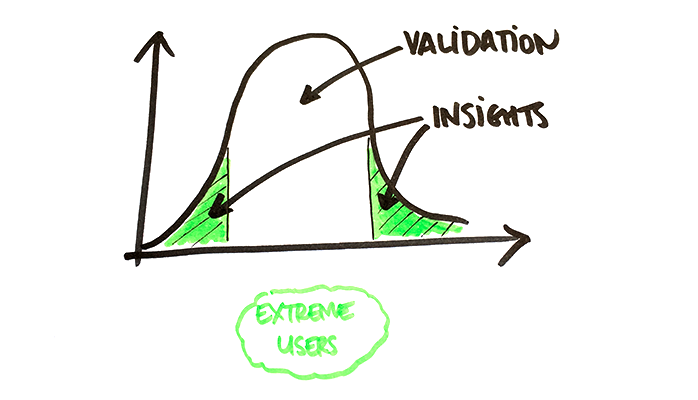
Be Clear On WHO you is Your End User
In my mind, I was also redesigning for students who haven’t been served by our school system. I got into education to serve oppressed students, specifically students of color, who have been disenfranchised by our education system. So if I am looking at something as large as a bell schedule and master schedule, I should be re-designing for my African-American students, low-income students, boys in particular, and English language learners.

These students are the canaries in the coal mine. They end up underperforming (by traditional measures), resisting the structures (defiance, truancy, missing assignments), and dropping out (pushed out). They are slowly dying like canaries in the coal mine, we call public education. The problem is that we we allow them to die off, while a small group of folks survive. We NEED to do better. We can’t just redesign for our “gifted and talented students.” We need to re-design for our extreme users, the students literally at the margins. Of the bell curve. Of society. In the classroom (the back). And in schools.
Let’s bring them to the center, of everything, the curriculum, the pedagogy, our policies, our budget, and our structures. At Visitacion Valley Middle School, we saw that our English language Learners, in particular, were not given access to our elective programs because they needed to take English language development during that same time. And in looking at our school data, we also realized that students were in need of severe reading intervention but in order to take it, these students to would lose access to arts and elective classes.
So we needed to do something about it.
Something big.
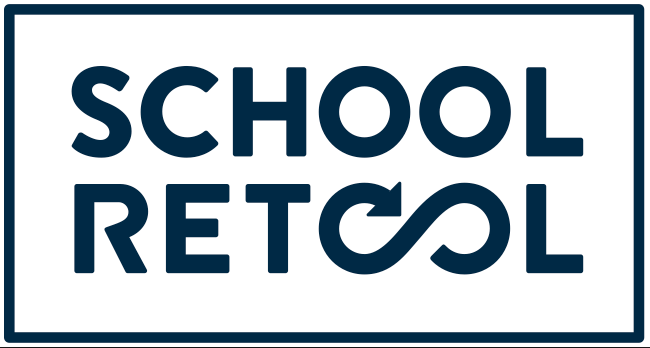
Inspiration from Design Thinking
About 2 years ago, I had was a part of Stanford University’s School Retool Program. This exposed me some of their Deeper Learning Big Ideas to transform schools and we looked at models from other schools. We actually visited a few such as Oakland International High School and Design Tech High School.

Within my school district, SFUSD, we had monthly meetings (led by the ILAB) with all the principals, where we were learning about how we might redesign our bell schedule. Through this process, we learned about design thinking, heard from experts in the field, and visited schools. We were able to see examples of other school schedules and pre-plan the process that we would end up using at our particular sites.
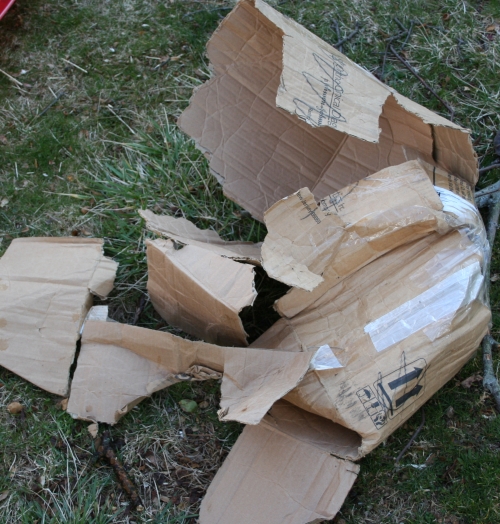
Rip Up the Box
As I was thinking about sharing this catastrophic event, with our staff, I knew that I needed to do something different. A powerpoint wouldn’t cut it. I decided to do something a little more theatrical and visual. We were in a faculty meeting and I wanted to explain why it was imperative that we redesign our bell schedule.
I walk in holding a cardboard box, labeled Master Schedule and Bell Schedule. I say “We have so many priorities to think about when creating a master schedule and bell schedule. Often times we try to figure out how we are going to make day them all happen.”
I had each priority written on a piece of paper, such as access to electives, reading intervention, Math, English, Science, and Physical Education. As I read each of these priorities I put them into the box. Then I said, “It’s clear that all these things can’t fit into the box because there are only six periods in the day, and which one do we take out because it doesn’t matter.”
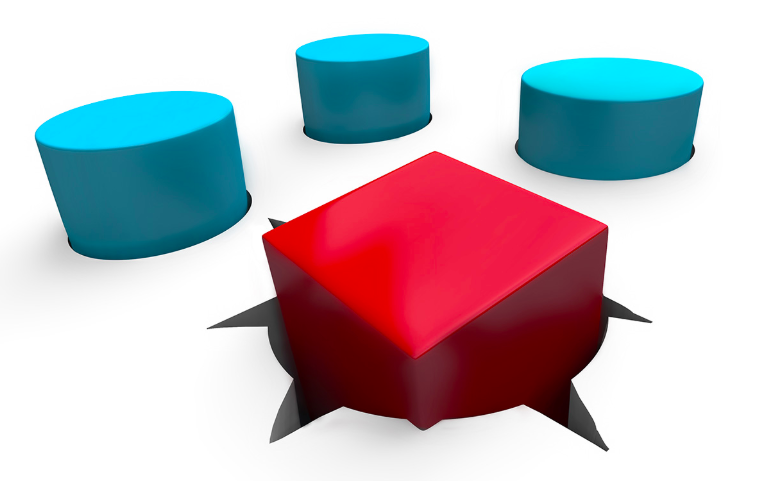
I continue, “We know that our students need more, and we know that our students deserve access to Arts electives and choice classes.” Then, I said “Who’s to say the box has to look like this? Instead of reshaping the Box what if we just tear the Box up?”
And then I ripped up the box, and threw to the side of the room.
I shared that we were embarking on a process to redesign our structure at our school to figure out what really meets the needs of our students, is consistent with our foci, and is innovative. Then I invited folks to join the redesign team. Reflecting on that meeting, it was definitely a turning point.
Form a Team to Ideate and Define
At our school, I sent out an email and I invited anyone who was interested in being a part of our bell schedule redesign team. There was some interest and we started working through the phases of design thinking. Here is our running agenda for the year. We started with a question of “How might we redesign our bell schedule to better meet the needs of our students?”
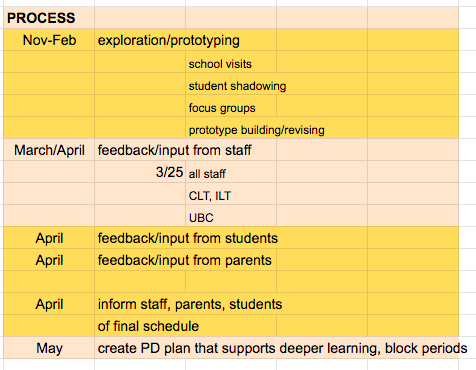
Each member selected different ways of gathering information. Some folks shadowed a student for the day, others visited neighboring middle schools, and others did research online. We administered a survey to our students and staff and ultimately created about 6 prototypes. Along the way, we got feedback from staff and altered our prototypes slightly. We learned more about the parameters from our central office and whittled it down to two or three options.

Empathize: Shadow a Student
During this year I chose the shadow a student for a full day, including breakfast in the morning every class, lunchtime, and socializing with friends. I chose an African American student, who didn’t talk very much. I was curious to know about their experience and to remind myself what it’s like to be a student at my school. If you are thinking of doing this, pick a student that is not being served by your school. Pick an extreme, marginalized, or oppressed student.
While shadowing, I noticed that there’s a lot of sitting.
A torturous amount of sitting.
There’s also a lot of time working individually, on worksheets, and listening to other people talk, oftentimes the teacher. This particular student was silent and was not even prompted to talk. It made me wonder how long students sit in classrooms silent. I often was tired, sometimes was bored, and did not feel very inspired. I was feeling empathetic and guilty in this whole situation.
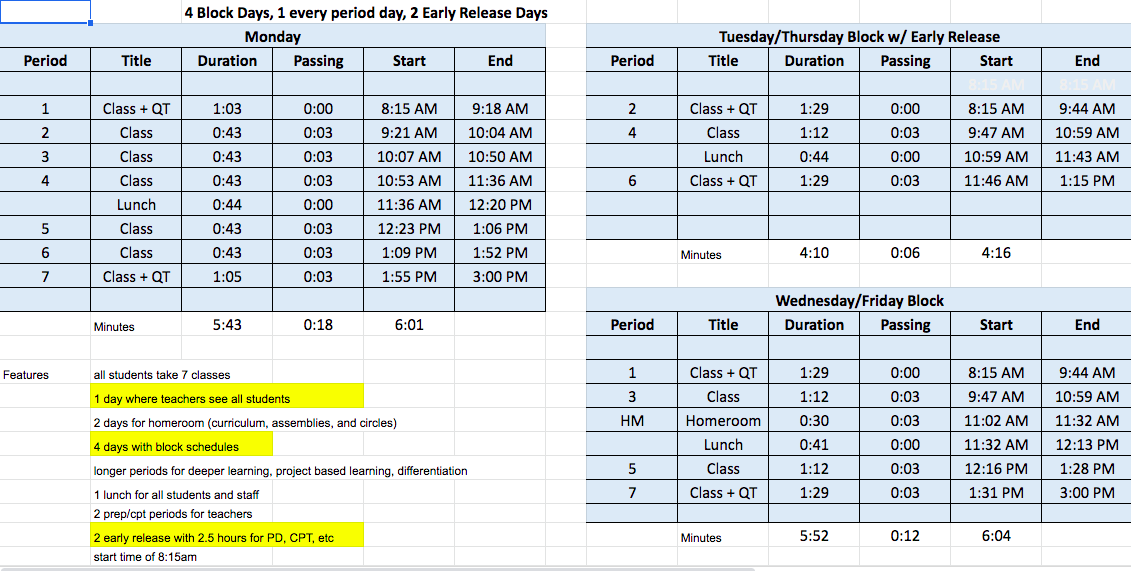
Ideate & Create Lots of Prototypes
Here are our actual prototypes. We looked at schedules that were blocked everyday, a hybrid block, and schedules that had different period lengths all week. We also looked at schedules that preserved our two periods of meditation you stay schedules that had one meditation session and schedules that had zero sessions.
As we looked at each prototype and ultimately shared them with staff, we tried to show the benefits and costs of each prototype as well as the logistics involved with making that shift. Ultimately, staff voted on their top choices and I made a selection that best combined our priorities, staff sentiment, student needs, and my vision.
Surprises from the Test Phase
- I didn’t realize how much time we would end up with for staff professional development and common planning time. That was a huge bonus. (Here are ideas for breathing life back into your meetings.)
- I also didn’t know that we would end up with early release time and it would be so valuable.
- Originally had one homeroom. And many thought the two sessions were too much, however during the school year I realize how valuable it is to have that time when we can do community building, host assemblies and more special events
- At first, staff very worried about going from 50 minute periods to 72-minute blocks, but after six to eight months most people were huge fans of the time and could not believe how we packed so many short classes into one day before.
- Meeting after school is so much calmer than trying to meet in the morning, even though people are a little bit tired
- Once we created a 7th period for intervention, for both Reading and English Language Development, everyone started thinking a lot more about intervention and wanted to do a better job at scaffolding their lessons, giving access to students with lower reading levels, and supporting our English language learners more.
- I knew there was going to be resistance and hurt feelings but I didn’t know how hard it was going to feel and how much tension this will create. We went into the summer with a lot of angst and worry.

Lesson Learned and Conclusions
- Go slow, if I were to do this again I would suggest spending the entire year on it and starting early
- Get as much feedback as possible at every step along the way so that people are in loop. This also includes sharing your mission, equity vision and purpose over and over again. The message will get distorted and if you do not supply one, an unproductive purpose will be established for you, especially by folks who do not support the change. (see this reading for more on the war of paradigms)
- This is about the students. It’s easy to forget that and let other people distract the work. We must be explicit that we are shifting the power, especially for our marginalized students.
- I wish I went harder on the mindset work, anti-racism, and white supremacy culture. I also wished I shared enough data and student testimonies as we were redesigning.

We are trying to keep the canaries alive at a minimum. We want them to thrive, be successful and happy. Moving students from the margins will help. Tearing up the box helps.
So does blowing up your bell schedule and master schedule.

